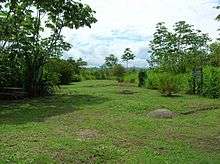South Pacific Costa Rica
South Pacific Costa Rica is likely the greenest part of the country, and offers a number of national parks, such as the Chirripo National Park.
Cities
Other destinations
Understand
Get in
Get around
The "Costanera Sur" (a southern coastal road) is paved all the way from border to border. Coming from the Central Valley, you can choose between the coastal route and the Panamerican Highway (which passes Pérez Zeledón and goes into Cartago).
On the main roads between Pérez Zeledón and Paso Canoas, TRACOPA runs several buses which also connect to San José and the Central Valley.
See
Osa Peninsula, where you will find Costa Rica’s jewel of the National Park System, Corcovado National Park. Osa continues to provide adventure travelers with great photos of monkeys, tapirs, cats,dolphins, whales and exotic birds. It’s a 5-hour drive from San José vs. the usual trek over the mountains and through raging rivers. Navigating pot holes the size of Hollywood swimming pools are now cherished memories.
The days are over when you just abandoned your rental car along the side of the pothole-riddled road and hitchhiked your way to Puerto Jimenez. New asphalt, bridges, painted yellow lines, passing lanes, guard rails and bus stops in each town. You could certainly sneak under the radar and land a small plane just like the old days. Puerto Jimenez was a dusty old gold mine town in its heyday, built completely in support of eager and persistent gold miners.
Dirt roads came to the Osa when Nobel Peace Prize winner Oscar Arias was President of Costa Rica in the early 1980s and he signed a deal with Ronald Reagan. The Roads for Peace project was born and the US Army Corps of Engineers began building roads, bridges and schools. USA could keep a close eye on all of the Ollie North and Noriega activity in the mountains high above the city of David, Panama. Costa Rica and Taiwan were the only two countries that benefited from the short-lived Roads for Peace program.

Coincidentally ICE has upgraded the electrical capacity in the area and there are several new airstrips and 3-G wireless technology.
Puerto Jimenez is starting to catch up with the rest of the world. With the new road and improved infrastructure, Osa could be ready to join the ranks of Tamarindo and Jacó.
Most people visiting the Osa Peninsula usually plan a week or two vacation, and that can get expensive while staying at beach lodges and resorts, especially if you are traveling as a family. Most people want to stay on the beach when visiting Southern Costa Rica, but what most people don’t know about Costa Rica, is that beaches are unbelievably hot! Full of purajas (sand fleas) black sand and open to the public, so you don’t get the privacy you deserve while you're on vacation. Most of the lodges and eco-resorts on the Osa Peninsula are off the grid, so adequate power, hot water and the 5-star amenities our civilization has grown to expect are a hit and miss.
One UNESCO World Heritage site is located in this region — the Precolumbian chiefdom settlements with stone spheres of the Diquís. Entrance 6USD, 4USD (foreign students), 1,000CRC (nationals).
Do
- Visit the Finca Sonador 30 km south of Pérez Zeledón. The Finca Sonador is a refugee project founded in 1979. Nowadays 400 families live in the community, growing mainly coffee and sugar cane besides the food they consume on their own. Tourism is still a supplementary income here and money goes straight into the families you stay with.
- 🌍 Mountain Hiking. The mountains near San Isidro de General are probably the most alpine mountains all over Costa Rica. If you are a keen hiker interested in a Nepal-like feel, head here for some serious adventure. Check out Chirripo National Park for more information.
Eat
Drink
Go next